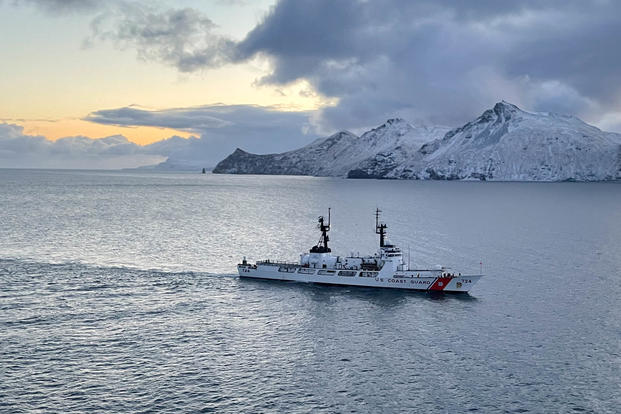The Coast Guard will say goodbye Saturday to the last of its workhorse open-ocean cutters of the past 50 years, the 378-foot high endurance cutter Douglas Munro.
At 49 years of service, the Hamilton-class cutter Munro will be decommissioned in a ceremony at Coast Guard Base Kodiak, Alaska, heralding completion of Deepwater, a replacement effort for the service's long-haul vessels that began in the late 1990s.
"Saturday, April 24, marks the end of an era -- an era spanning a half-century where the Coast Guard fleet of 378-high endurance cutters plied the world's waters, modeling the maritime rules-based order," Commandant Adm. Karl Schultz said Wednesday. "Cutter Douglas Munro compiled a storied half-century record of significant at-sea rescues and law enforcement actions."
The first ship in the 12-cutter Hamilton Class was commissioned in March 1967; the Munro's keel was laid in February 1970, and it was commissioned Sept. 27, 1971. The Munro, named for the Coast Guard's only Medal of Honor recipient, Signalman First Class Douglas Munro, was first homeported in Boston. It would make subsequent stays in Seattle, Honolulu and Alameda, Calif., before moving to its final homeport in Kodiak in 2007.
Read Next: Navy Pulls Way Ahead of Other DoD Services in Race to 100% Vaccination
The Munro's accomplishments over the years include the search and recovery efforts for the passengers of Korean Airlines Flight 007, shot down by a Soviet aircraft in 1983; the rescue of all 27 crewmembers of the container ship Hyundai Seattle as it burned and lost power in heavy seas in December 1994; and the interception and seizure of dozens of vessels conducting illegal fishing and smuggling drugs and migrants.
In one of its highest-profile rescues, Munro responded to the sinking of the factory fishing vessel Alaska Ranger on Easter Sunday 2008. The ship, 100 nautical miles from Munro's position, had 47 crew members on board, caught fire and was taking on water.
In a heroic effort, the Munro's crew of 171, most of whom were in their first enlistment, rescued 45 of those 47 crew members from heavy seas and 32-degree water.
The gripping rescue was captured in a riveting speech on the Senate floor by Alaska Republican Lisa Murkowski and in a longform article, "The Longest Night," which appeared in GQ magazine in 2008.
According to GQ, after a long flight from Saint Paul, the flight commander of Munro's MH-60 Jayhawk helicopter, Brian McLaughlin, spotted a strobe light on a crew member's dry suit, and then another, and the race was on.
"From the back, [rescue swimmer O'Brien Starr] Hollow heard one of them gasp, say, 'What the hell' … Hollow saw all those lights, too, dozens of them, sparkling and scattered for more than a mile, hiding behind waves, then blinking back when the swells passed. There were too many to count ... Those lights were all people bobbing in very cold water."
Hollow and the crew of the Jayhawk managed to lift 12 survivors from the water. Munro's MH-65 Dolphin helicopter and its rescue swimmer, Abe Heller, plucked five from the sea before the smaller chopper needed to return to the ship. Heller stayed behind in a life raft with three other survivors waiting for the Jayhawk to return.
In all, the Munro rescued 20 and recovered one body; the remaining 22 survivors and three deceased crew members were picked up by Alaska Ranger's sister ship, Alaska Warrior. One crew member was never found.
Heller was awarded the Distinguished Flying Cross, and the Munro received a Coast Guard Unit Commendation as well as citations from the Alaska legislature and Congress.
Munro's namesake had shown the same selflessness and daring during World War II. The signalman first class, in charge of two landing crafts and eight Higgins boats, was tasked with transporting Marines under the command of the legendary Lt. Col. Lewis B. "Chesty" Puller to Guadalcanal to engage Japanese forces in September 1942.
But the Marines became encircled by the Japanese and were forced to fight their way back to the beach, where Munro's boats returned to extract them. Munro used his Higgins boat and its .30 caliber machine gun to move close to shore and protect the retreating Marines. He then used the boat to shield Marines as they returned to the other landing craft.
In his effort to save the Marines, Munro was fatally shot in the base of the neck. He was posthumously awarded the Medal of Honor on May 24, 1943, and he remains the only non-Marine whose name is on the National Museum of the Marine Corps' Wall of Heroes.
"Coast Guard Cutter Douglas Munro and those who sailed aboard her clearly embodied the heroism and bias for action of its namesake, Signalman First Class Douglas A. Munro," Schultz told Military.com.
Munro's legacy does not disappear with the decommissioning of the high endurance cutter Munro, however. Since 2017, the service has had two ships named Munro: the National Security Cutter Munro, part of the Legend Class built to take on the missions of the retiring high-endurance cutters, was commissioned in April that year.
The service currently has nine national security cutters with two more under construction.
-- Patricia Kime can be reached at Patricia.Kime@Monster.com. Follow her on Twitter @patriciakime.
Related: ‘Very Difficult Environment,’ Coast Guard Offers Incentives to Entice Recruits













